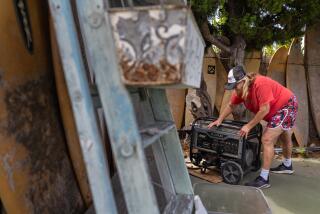Crumbling Memory : Demolition Begins Today on Apartments Where 16 Died in Quake
NORTHRIDGE — The memorial flowers left by mourners in the chain-link fence surrounding the Northridge Meadows apartments have long turned to brown--the ribbons faded, the petals crumbling to dust at a touch.
Demolition of the apartment building where 16 people died in the Jan. 17 earthquake begins today. Even sweat shirt salesman Lou Elliott--who finally struck gold after landing a spot next door to the quake’s most notorious deathtrap--figures it’s time to move on.
“I’m having a close-out sale,” said Elliot, whose earthquake sweat shirts were marked down Sunday, 2 for $25. He plans to close up shop--a card table--and return to the Bay Area.
But as they have for more than three months, dozens of people every hour on Sunday took the short walk past the front of the 163-unit apartment complex on Reseda Boulevard that looks, at first glance, like just another broken building.
That is, until someone points out that this two-story building was once three stories, and that the dead were in first-floor apartments that have almost completely disappeared.
“Oh jeez, oh jeez, oh my God,” said Nadine Bufanda, a tourist from Tucson, Ariz., when she learned.
Former tenant Eva Amdur, 80, who came by Sunday to find out how to get her belongings out of apartment 206, is angry that they still come to look.
“What’s here to look at? You can have pleasure out of it?” she said. “At 4:30 a.m. they are telling you to leave your apartment, to get outside without even taking your coat. I had nothing.”
Building experts hired by all sides in the lawsuits filed as a result of the deaths will conduct a so-called controlled demolition of Northridge Meadows over the next two weeks. The city has scheduled complete demolition of the complex starting May 12.
Before then, attorneys hope to find evidence of whether workmanship, design or materials contributed to the collapse of the 22-year-old wood-and-stucco building.
Some have charged that the owners and builders were responsible for the building’s failure. Those accused say it was an act of God.
“But look at all those other buildings, the same style and materials, they didn’t fall,” said Elaine Weiser of Woodland Hills, who stopped by Sunday to see Northridge Meadows.
Her husband, Bob, taking the other side, shrugged and said, “Elaine, it’s an earthquake.”
Like other visitors, both were moved by the sight of the building, which has come to symbolize the Northridge earthquake worldwide. With its chain-link fence and 24-hour guard protecting it against looters, the building remains a nearly undisturbed snapshot of the earthquake’s destruction.
Mattresses spill out of doorways, clothes haphazardly piled into boxes wait for their owners; inside an apartment, a television is still perched on a dresser.
“We came here to see it and to understand it,” said J. J. Gjedsted, 51, who brought his family from Copenhagen to visit Los Angeles and Northridge Meadows. “We saw this on TV, but you have to see it in person to really understand. We live in a country with no earthquakes. This is scary.”
Mary Pat Garry and Brenda Mish came from Phoenix to attend the Country Music Awards scheduled for Tuesday. While they were in town, they decided to see if they could find Northridge Meadows.
“We were in the car looking,” Garry said. Added Mish, “We’ve just been lucky.” On Saturday, they took a tour of movie stars’ homes.
Visitor Vic Dushaune, 39, of Del Mar said he has come to Northridge Meadows to alert others that for the last several years he has been afflicted with headaches--”a throbbing pain”--right before major California earthquakes.
So far, he said, he has been afraid to tell authorities because they might get the wrong idea about him.
But “next time it happens,” Dushaune said, “I might just tell a newspaper.”
Walking home from Mass at nearby Our Lady of Lourdes Church, Mary Jane O’Connell said she has been tempted to bring a sign criticizing tourists who stream past Northridge Meadows.
“It’s upsetting,” said O’Donnell. “I wish all these gawkers would just leave. I think it’s morbid.”
Sweat shirt salesman Elliot said every once in awhile he has heard the same kind of criticism. Sometimes it is profanity yelled from passing cars, other times it is to his face. The message is usually about the same: Selling earthquake merchandise next door to the scene of such tragedy is tacky.
But Elliot said he has so far donated about $7,500 to charity, 75 cents for every $15 shirt sold.
“So I ask them, ‘How much money have you raised?’ ” Elliot said. “Or I ask them, ‘Why are you here? Why are you taking a look at where 16 people were killed?’ I mean, what’s tacky?”
More to Read
Sign up for Essential California
The most important California stories and recommendations in your inbox every morning.
You may occasionally receive promotional content from the Los Angeles Times.










